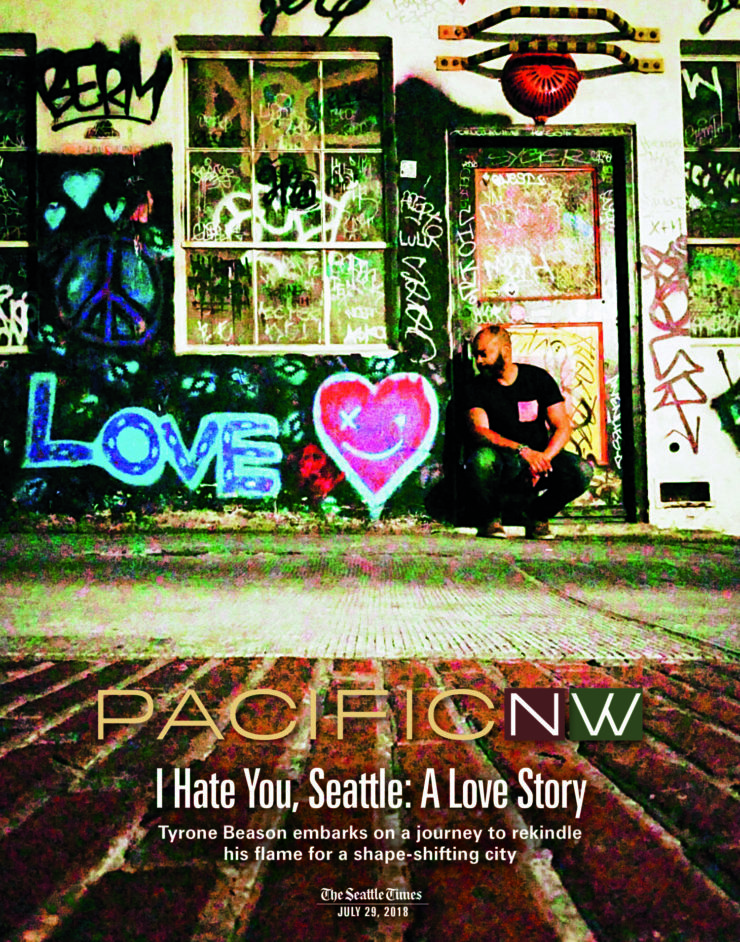Since Tyrone Beason moved to Seattle in the mid 1990s, the city has undergone record-breaking growth and transformation. Gone are the funky old hangs of the 1950s and '60s, the low-slung brick stores lining the streets, the warrens of warehouse districts – most replaced by glass-and-steel highrises, hip restaurants, unaffordable (for most) apartments and scarce parking. But gone, too, are the days when Beason sported untucked plaid shirts and spoke with a southern accent. Today, like the city, he’s more confident and refined in his vintage whiskey-colored boots and gray sweater.
Change is constant – in cities and people. When it comes too fast, or erases what was known, it has a way of making us uncomfortable. After 20 years in Seattle, Beason found himself supremely so. That discomfort, and a fair bit of desperation, pushed him to try to see the city anew. Along the way, he learned to report in a new way. In his last piece as a feature writer for The Seattle Times' Pacific NW Magazine Beason literally put down his spiral notebook and pen, picked up his Samsung Galaxy 8 and started to rediscover the city through images rather than words.
“I wanted to confront my own uneasiness of what Seattle was becoming,” Beason said. “I can see it is dazzling, but I feel as if I don’t quite belong here and that bugs me."
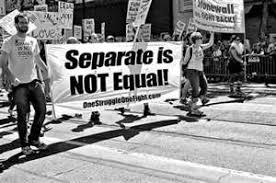
Depressed and on the brink of leaving Seattle, Beason was ready to share what was on his mind, but wasn’t exactly sure how. A conversation with Italian photographer Maïmouna Guerresi inspired him when she said, "To know something, you have to see beyond the obvious.” So why not photograph his way through a love/hate story using his cell phone? Instagram became Beason's “living notebook,” where he chronicled Seattle's streets through photos, videos and text. Elements of the city he was grappling with lent him a hand at times as construction netting and sewer pipes played tripod.
Usually, within a few hours of taking a picture or filming a video, Beason would post it to Instagram with a few written reflections. No editors reviewed the posts. After a few weeks of posting, he realized that these posts weren’t notes for a magazine story – they were the story. When Seattle Times photographer Erika Schultz was assigned to partner with Beason to photograph his magazine piece, she told she would guide from behind, but the photos needed to be his.

“It wasn’t for me to interpret how he sees the city,” Schultz said. “I wanted to see the city through his eyes. His pictures would give the most authentic version of this story.”
After sharing dozens of pictures and videos on Instagram over the course of a few months, Beason’s essay was published in late July. "I hate you, Seattle: A love story" was his last story for the newspaper's Sunday magazine. (Beason has since taken on a newly created social justice column.) It reads like poetry, something Beason used to write a lot more of when he first came to Seattle. Honesty and a willingness to be vulnerable brought him back to this soulful piece of himself; maybe it could bring Seattle back to him, too – not to what it used to be but something different. Maybe even something better.
As a professional freelance photographer who takes more pictures with my cell phone than my camera, I was interested in knowing what made Tyrone turn to photographs, video and Instagram to report this story. Why did he want to share his mixed emotions about Seattle with the world? How did he decide what to photograph and when to share it? What did he learn from by reporting a story with images first? And how is his relationship with Seattle these days anyway?
Our conversation below has been edited for length and clarity. Magazine page spreads are used with permission from The Seattle Times.
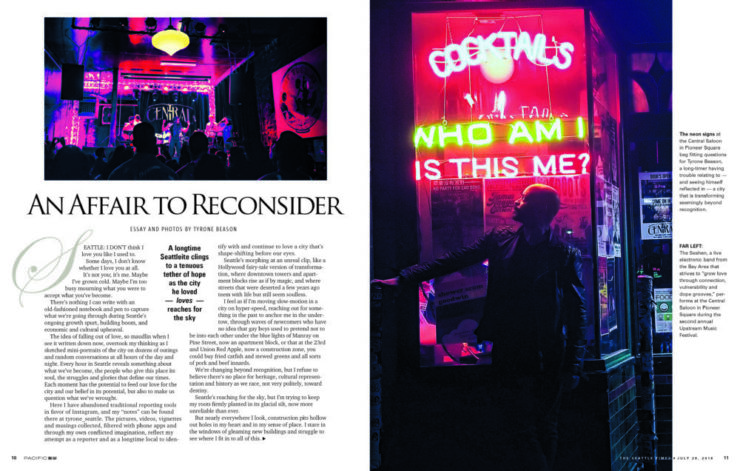
Why did you want to tell this story?
I was thinking about how this community had changed in the past 10 years or so. I have been a magazine writer for all of that. People at work and in my personal life were all talking about how expensive Seattle was becoming: how they couldn’t afford to buy a house, how they would never be able to live in the city the way they wanted to. So I was also thinking about how this city could sustain all the things that made me fall in love with it in the mid ‘90s. At the time, it was a very middle class city. Post-recession, as the city came out of that, we were blessed in a way to have these very large and successful companies and this wealth of idea and tech people who could help us ride that out and bounce back in an amazing way. But as those companies grow and attract people to the city in greater numbers, it poses the question: Can we maintain the things that keep long-time folks here and existing populations stable?
In a decade, my middle class was replaced by new money, by a new middle class. Now the average salary for a software engineer, last time I checked, was $120,000. Suddenly, I became lower middle class. How does a culture and a spirit of a place change when it prospers and when it grows?
How does a culture and a spirit of a place change when it prospers and when it grows?
I’ve written a lot of stories over the years about that sort of thing, but I wanted to do a piece that felt very personal. I think Seattle has something very, very special, but it requires all kinds of people from different parts of the economic spectrum to sustain it. As it has become richer and economically exclusive, we’ve lost people of color – at least the old-school kind of communities of color. You have to leave the city limits to see large immigrant communities anymore. We are watching the city lose those defining qualities and acting like we are helpless. Yet we are probably better positioned than any place in the country to intervene in these crises. We have to find a way to work more collaboratively.
How did you decide where to go and what to photograph? I noticed a lot of contrasts within the stories you shared. Did you intentionally seek that out?
I wanted this to be a diaristic exploration of the city. Almost like taking a picture of something – knowing that 30 minutes from now that scene won’t even be there anymore – for posterity, before we lost all of it. I wanted to write about it as a place I know less and less. I feel as if Seattle has become less familiar to me, and I didn’t know how to do that in a straight journalistic way. So I just decided to explore. I thought maybe my feelings of negativity toward the new Seattle needed to be unpacked. Maybe I needed to have a little bit more of an open mind or try to find things that I can still embrace in the old Seattle – and the new one.
I can’t write about my home and act as if I don’t live in it.
What you are seeing are my little bursts of inspiration. Five minutes after the fact I would wonder: Why did I take that picture? None of it was planned. You don’t have to look for contrasts that hard in a city where there are literally people sleeping in tents everywhere and the most construction cranes in America. You just have to be willing to open your eyes to what is all around you.
A couple of those pictures are from a place called The Nest. It has a very polished, upmarket look. I’m an African American guy, and I complain so much about being in settings where I am the only black dude, and there is kind of an urban professional crowd there that includes a lot of African Americans, people from different parts of Asia, women and men, gay and straight. It’s young Seattle, it’s sort of new Seattle, but it also feels very comfortable for me, unlike a lot of settings that feel very exclusive. I don’t know how they achieve that. As much as I want to hate these more polished settings, I kind of dig it. I don’t want to be dishonest with the audience about that. It may seem jarring to see people who are suffering and feeling excluded mixed in with pictures of Seattle in this Golden Age with me enjoying the amenities that come with it. But that, to me, is an honest assessment of being an urban person.
I’ve never reported using social media before. I was always very, very reluctant to share my photos on Facebook or even with friends. That’s my own take on the world and my community; I revel in those images. So I thought, do what’s not obvious for you as well. Share these images and give your audience a chance to see the world as you do, as you are trying to make sense of it. And make yourself vulnerable. It’s a way for me to share what’s going on in my head as I do the work. And to show people not just what I saw, because anyone can take a picture, but how I saw it.
There was a series of videos you captured of Eddie McFerrin, a shoe shiner in Pioneer Square, that you held onto for a few weeks before posting. (NOTE: It comes 28 seconds into the final video cut for the magazine.) Tell me about the hesitancy to share his story and your thought process behind how you chose to tell it.
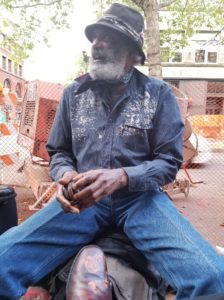
I thought about the power and racial dynamics of that moment. Two African American men, one getting his shoes shined, one shining those shoes. I have a real problem with the way we sometimes talk about people of color in the newspaper. So I waited a little bit to figure out how to present this aspect of lovable Seattle in a way that meant something for the readers. I’ve walked by (McFerrin) for a few years without getting my shoes shined. I didn’t want to feel as if I was making an old black man serve me.
So I thought to myself, you’re thinking about the economic dynamics of this city, this very rich and poor city, and this man is trying to get you to part ways with a few dollars by shining your shoes, and you won’t do it? How are you helping him? I am trying to be like this righteous brother in that moment and not belittle an African American senior. He’s out there hustling, and I appreciate that about him. He smiled at me for years without me getting my shoes shined; he never gave up his grace and generosity toward me. But I never gave up some dollars to him. So I’m thinking, you need to get your shoes shined but make this a moment for both of you.
He smiled at me for years without me getting my shoes shined; he never gave up his grace and generosity toward me....I could tell the community about him but why not let him say it?
Instead of pictures, I posted several videos of my interview with him. I could tell the community about him but why not let him say it? I didn’t want to be looking down on him as he was shining my shoes. I held the camera so it is looking directly at him or tilted from below. He was taking care of me. He was doing something that he does very well and, in exchange, I’m giving him money. I felt we were equal.
Characters like that who kind of stop you in your tracks, that is why I love this city. Seattle is full of people like that, very good storytellers who don’t even know it.
What did you learn from the experience?
A story can be anything you want it to be. A story is a very beautifully crafted representation of an experience. In my case, the experience is being out in the world, talking to people, living my life. This was the most redeeming and gratifying thing I’ve ever done as a journalist. A journalist’s notebook is sacred. That material is what grabbed me. It’s what I heard, it’s what I saw. I didn’t give up my notes. What I did was I made everything I did an act of note-taking. And I made all of those notes publicly available, to make the whole experience transparent so you not only got to see what I saw and read what I wrote – you really got a sense of how I process the world around, using my own personal story, using my own identity as the foundation.
The country is going through a lot of change, Seattle is too. I think we should revel in our role as conscientious observers and crafters of our time, to put together images and words that people 20, 50, 100 years from now can look back on and get a real sense of what we were going through. Nothing is throwaway. It’s all material. Think about your random acts of journalism as journalism for the times. It helped me to step up as a writer, and some of the most beautiful things I’ve written were written on Instagram, not in The Seattle Times.
In journalism, we are often taught to maintain professional distance and keep ourselves out of the story. How did you decide to make yourself part of the story?
I felt more open to the possibility for emotional honesty, for 100 percent transparency as a way to connect with the reader/viewer. I did not want a single person to doubt where I was coming from with this piece. That’s why the posts are very honest and introspective. I have been experimenting with new kinds of journalism the past couple of years, and there is nothing wrong with being who you are in the service of good journalism. You are practicing a kind of deception when you act as if you, as the writer, photographer, designer, aren’t involved in what you produce. The reader understands that in this business we all come with perspectives that influence our work. Sometimes we run away from that reality or try to conceal it, and what I wanted with this piece was not to do that and to feel very free.
Seattle is my home. I can’t write about my home and act as if I don’t live in it. I think you can be thorough, but I don’t think you need to be objective about something like this.
I’m a pretty thoughtful person but, more than that, I think with my heart and not just with my head.
I live here, and I love it. I’ve spent all this time exploring the soul and spirit of this community and region. I’ve had to sit in people’s living rooms and look into their eyes as they tell me how afraid they are that they can’t live here, and I’ve been in some of the most esteemed settings in this community. I’m a pretty thoughtful person but, more than that, I think with my heart and not just with my head. I never forget about what all this is supposed to add up to. A person’s story is their greatest possession, and it’s a privilege to be given it and to share it with other people.
In the end, you didn’t leave Seattle. As you were finishing this story, you accepted a job as the social justice columnist for the Seattle Times. So, I must ask, what is your current relationship status with Seattle?
We are in couples therapy. We are working on our issues together, and I’m trying to be a better listener. I’m trying to be a little bit more open to what is going on and trying to listen with a more open heart. I think that is good in interpersonal relationships but also with a city that’s in flux. Have mercy because everybody makes mistakes and gets things wrong, including me. So that’s where we are.
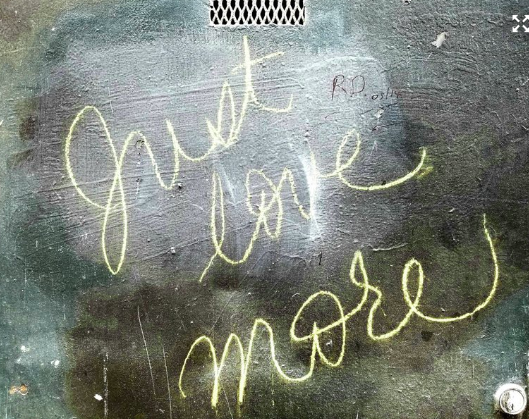
Postscript: Beason followed up his July magazine piece with a story published Dec. 24, 2018, about a homeless man named Chance. Chance was leaving Seattle in search of milder climes, but somehow found that a piece of his Seattle sidewalk art, declaring "Just Love More," was a prominent part of Beason's piece.
